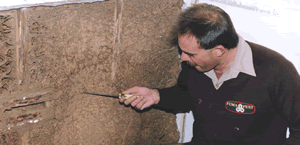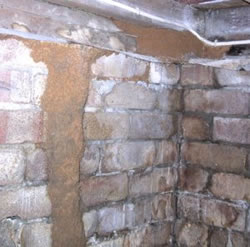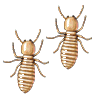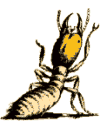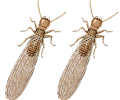| Subterranean Termites - USA |
| The destructive nature of subterranean termites |
| |
Subterranean
termites are a highly destructive timber pest, causing major structural
timber damage to domestic / commercial buildings in the USA.
Recent
industry surveys suggest that most homes are at risk of a subterranean infestation
particularly in warmer more temperate climates.
Severe
termite damage to buildings is on the increase since the removal of the
long lasting soil barrier chemicals; the more common use of softwood building
and other landscaping timbers that termites find irresistible. Other important
factors include building designs, automatic watering systems, landscaping
and maintenance that encourage termite activity and/or allow hidden termite
entry and infestation into a building.
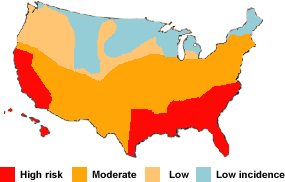 |
Destructive Termite Risk Assessment |
Termites that live in the Ground and can eat Your house down
....
Termites are known to destroy the wall and roofing timbers of a home
within 3 months of construction.
Termites cause more damage to homes in USA than fire, floods, storms
and tempest, combined.
Termites occur throughout most states of the USA, with a high incidence
of attack in virtually all urban areas.
PLEASE NOTE: Severe termite damage to a building is not uncommon.
To compound the problem, your Home or Building Insurance Policy will
NOT cover the repair costs of any timber damage caused by termites. |
Subterranean
termites are small in size (about half the size of match-head) and soft
bodied insects. They build a central colony nest from which they construct
underground tunnels that radiate within a 100 yard radius from a central
colony nest in search of a timber (cellulose) food source.
The picture on the left shows a termite inspector examining an above ground
termite subsidiary nest built inside a wall cavity of a home.
Termites often
build such nests if moisture is allowed to regularly collects inside the wall
cavity, say from leaking pipes, shower recess, faulty plumbing, guttering,
broken roof tiles, etc. |
Termites travel in humidified mud-shelter tubes
or galleries...
The picture on the left shows a mud shelter tube that subterranean
termites have constructed over a solid object, in this case, a brick
foundation wall in the sub-floor of a cottage.
Subterranean termites
travel in these mud shelter tubes as protection from predators, sun-burn,
dehydration and to maintain a high humidity environment which is
essential for their survival.
Subterranean termites are highly secretive,
preferring to enter a building through areas inaccessible to inspection,
such as, through in-fill patios, fire heaths, expansion joints and
cracks in concrete slab (on-ground) flooring.
Subterranean termites
can pass through a 2 mm crack or an expansion joint (eating through
the rubber compound) between adjoining concrete on ground flooring.
They can also travel under parquetry and floor tiles to get to the
wall framing timbers. |
| |
|
| Termites have a symbiotic digestive system |
| |
Only the worker termite caste can digest timber by the use of symbiotic protozoa in their gut. Worker termites feed their partly digested semi-liquid food, regurgitated from their mouth or passing from their anus, to the other termites, a process known as trophallaxis.
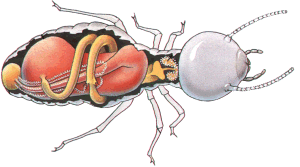
|
Termites have a well ordered social system with amazing engineering capabilities and an acute survival instinct; they obtain moisture from the soil and moist decaying timber, and communicate using pheromone signals.
The mutual feeding, constant grooming and close social habits of termites
are used to advantage in modern termite control baiting systems. |
Certain hi-tech termite baits are now on the market that have a delayed
lethal effect on termites which readily pass on the bait to other termites
in the central colony nest during the mutual grooming and feeding.
 |
Subterranean termites need to maintain a high level of humidity and temperature (25 to 35c) in their central colony nest.
Termites eat through the centre of susceptible timbers leaving nothing but a thin veneer of timber and/or paint. They will pack mud in cracks and joints in timber to prevent loss of humidity and resultant dehydration. |
|
| |
| The
biology and behaviour of subterranean termites |
| |
Subterranean termites or "white ants" are not ants at all. Termites are in fact super specialised cockroaches with a similar 200 to 300 million year evolutionary history.
Within a termite nest there are members of different castes, each with a different role to perform and all interdependent upon each other for survival of the colony. These include the queen, king, the winged reproductive (young kings and queens), soldier and worker termites.
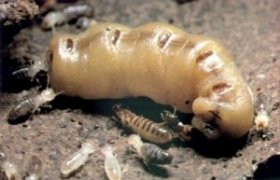
The king, queen and worker termites. |
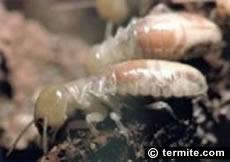
Worker termites - thin external skin. |

|
The queen termite is an egg laying machine; her body is enormous
compared to her off-spring; she can live more than 25 years and produce
more that 2,000 eggs a day. |

|
The king and queen live in a central chamber and are tended by
the workers. |
The workers are by far the largest
cast in the termite colony and
the one that does the damage; they are a creamy translucent colour, soft bodied and carry out all work in the nest, including gathering food (timber and other cellulose); constructing tunnels; repairing and enlarging the colony nest; grooming each other and feeding the soldiers, the king, queen and also caring for the young nymphs until mature.
Worker termites are 1/8 to 1/6 inches long, have no wings, are sterile
and blind; work 24 hours a day for several years life span in some
species. |
The soldiers commonly have an orange
coloured armoured head
with mandibulate pinchers which they use to crush an attacker, such as ants; some have hard pointed snout which eject a white sticky latex to ensnare their enemies.
The soldier termite is usually the first to be seen in large numbers
when any active termite workings (shelter tubes or damaged timber)
are opened. Soldier termites will rush out to guard the opening whilst
worker termites repair the breach. |
The swarmers (reproductives) are
called "alates"
and are commonly seen when they swarm on a hot humid summer evening around dusk; they have eyes; are poor fliers but are swept along by the wind; they land, drop their wings, find a mate to become king and queen of a new termite colony.
The swarmers are emitted in their thousands when a mature termite
nest is large and well established. They land, shed their wings and
attract a mate by pheromone chemical signal. If you find swarming
termites, it is a sure DANGER sign that a large termite colony nest
is close by. Contact Us immediately to assess the situation. |
|
| |
| The life-cycle of subterranean
termites |
| |
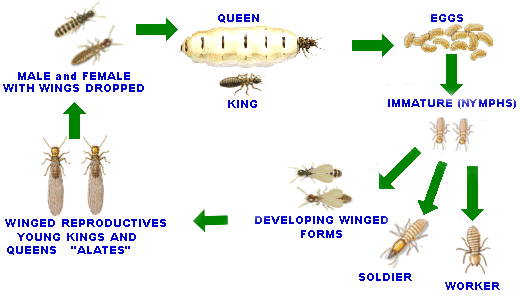
As noted above, termites constantly groom and feed each other. A valuable
technique for the termite controller is to instal and monitor a termite
baiting system next to any live activity found in and around the premises
where termite foraging is most likely to occur. Subsequent inspections (preferably
monthly) may reveal dead or sick worker termites, they change colour to
a mottle look, and spread of the termite bait to other termites leading
to elimination of the colony.
The termite baits are designed to be non-repellant to the termites and has
a unique delayed effect. Time enough to be passed onto the other termites
in the colony including the queen, with a sufficient dosage leading to the
elimination of the entire colony. This process is explained in detail in
the Termite Control section of this website. |
| |
| If You find termites do NOT disturb them |
| |
Termites have acute survival instincts. If they are shaken up or disturbed,
the termites often will abandon the associated area and move on to secretly
cause damage in other areas in the building. If you find termites in or
around your property, it is essential that you do NOT disturb them and promptly
arrange for a professional inspection and application of a termite bait
to the live termites, if present in abundance.
 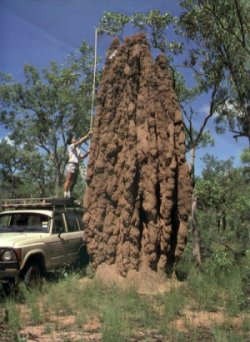 |
Subterranean Termites...
Mother Nature's most prolific builders
This picture shows a large above ground termite nest found in the
Northern Territory of Australia. In the USA, most of the destructive
subterranean termite species build their nest completely below ground
level.
A large colony in an urban environment is most often unseen, being totally below ground level with a nest containing more than a million termites - secretly eating the inside of your timbers leaving you an empty shell.
Find Out How to Protect Your Property
Click on Termite Control
| |
| |
| Subterranean
Termite Species in USA |
| Drywood Termite Species in USA |
| Dampwood Termite Species in USA |
| Learn about other common household pests |
| Published by Fumapest Group © copyright 1995
- updated:
|
|



